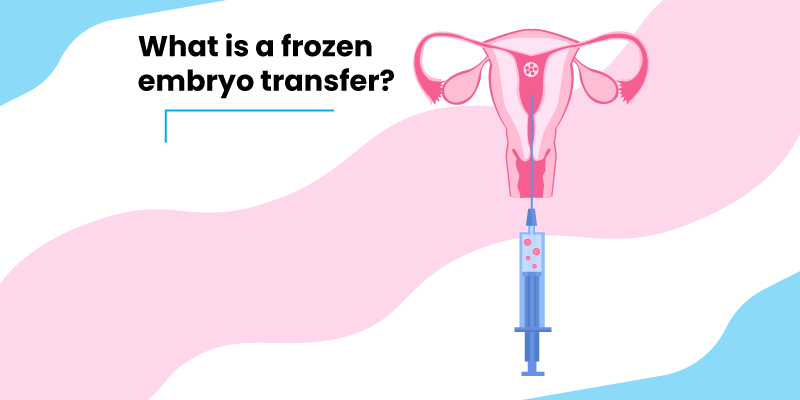Author: Dr. Hema Vaithianathan
Parenthood is one of the incredible experiences in life. Natural pregnancy may work out for some whereas some may need assisted reproductive techniques like IVF to become parents. Couples who take up IVF to attain their parenthood dream need to have a clear understanding of the processes involved. It is essential to know what a fresh embryo transfer and what a frozen embryo transfer(FET) means that would give you the confidence to undergo the entire treatment journey.
In an IVF treatment, eggs retrieved from the female partner and the sperms collected from the male partner are allowed to fertilise on its own by IVF process or a single sperm is directly injected into the egg in ICSI process which is then meticulously cultured for embryo formation. This embryo can either be transferred to the woman’s uterus within 3 or 5 days of egg retrieval or can be frozen and transferred to the uterus after some weeks, months, or years depending on several factors. Let us understand the frozen embryo transfer process, timeline, and success rate.
Who needs FET?
- In case of some women, who might have a high risk of developing Ovarian Hyperstimulation Syndrome (OHSS), due to hormone stimulation during IVF, FET is recommended wherein embryos are not transferred in the same cycle but frozen to be transferred later when the conditions are conducive for a transfer.
- Couples who are 35+ and couples who have genetic disorders for whom PGT (Preimplantation Genetic Testing) is necessary, need frozen embryo transfer. In case of PGT, few cells taken from the embryo are analyzed for chromosomal abnormalities and only those embryos that are healthy are used for embryo transfer.
- For women diagnosed with cancer, embryos can be frozen before cancer treatment and used later in the future to achieve conception.
- Couples who wish to postpone parenthood can have their embryos frozen which would help them preserve their fertility potential as fertility declines with age.
- In some couples when more embryos get formed, the extra embryos can be frozen and used for conception again in the future if the couple desires to expand their family.
How does FET work?
During the IVF process, after fertilization of the sperm collected from the male partner and the eggs retrieved from the female partner, the embryo formed is either frozen on the same day or is allowed to grow till 3rd day (called as cleavage stage) and frozen on Day 3 or it is allowed to grow till 5th day (called as blastocyst) and is frozen on Day 5.
FET can be in 2 methods;
1. Natural cycle FET
2. Hormone Replacement Therapy (HRT) cycle
Natural cycle frozen embryo transfer process:
- The thickness of the uterus lining (known as the endometrium) is one of the important parameters for a successful conception.
- In this protocol, no hormones are given for the development of endometrium. The woman’s ovulation process is tracked by scan, blood/urine test, and the embryo is then transferred according to the implantation window (the time when the uterus is ready to accept an embryo). A particular day is fixed for embryo transfer and on that day, an embryo is thawed and put into the woman’s uterus.
Hormone Replacement Therapy cycle:
This protocol is usually recommended in the case of women who have irregular cycles. Unlike the natural cycle, here Estrogen and Progesterone medications are given to improve the thickness of the endometrium. When the conditions are favourable, the embryo is transferred into the uterus.
Frozen embryo transfer timeline:
Step 1: Hormonal Treatment
Estrogen hormonal medication will be given to enable the inner lining of the uterus to thicken for embryo transfer. Progesterone support is also necessary to make the uterus get ready for the implantation process (attachment of the embryo to the uterus).
Step 2: Monitoring through Scans
Ultrasound scans/blood tests are done to know if the uterus is ready for implantation.
Step 3: Embryo Transfer
The embryo is thawed and transferred to the woman’s uterus for further development.
Step 4: Pregnancy Test
After 2 weeks, a pregnancy confirmation test needs to be done.
What is a single embryo transfer?
Usually, more than 2 or 3 embryos were transferred into the woman’s uterus till recently to improve the chances of conception. However,this procedure is associated with the risk of multiple pregnancies which may lead to gestational diabetes, preeclampsia, preterm delivery, and other complications for both the mother and the fetus. In order to reduce the risk of higher-order pregnancies, advanced technologies like PGT (Preimplantation Genetic Testing), can help in selecting the best embryo for transfer. By this method, just a single healthy embryo can be transferred thereby reducing complications. This process is called elective single embryo transfer.
Advantages of a single embryo transfer:
- Helps in the selection of 1 healthy embryo
- Reduces the risk of miscarriage
- Reduces the risk of multiple births
Fresh vs Frozen embryo transfer:
The time to conception is less in the case of fresh embryo transfer as the embryo is transferred into the woman’s uterus within 3 or 5 days after egg collection during the same menstrual cycle. The frozen embryo is transferred to the woman’s uterus in the subsequent menstrual cycle when the conditions are favourable enough for a transfer.
Embryo transfer success rate
Frozen embryo transfer is found to have a better success rates than fresh embryo transfer. However, many factors can affect the embryo transfer success rate.
- Age
- Type of infertility
- Quality of sperm
- Egg quality
- Embryo quality
- Receptivity of the uterus
- Lifestyle factors
Tips for a successful FET:
One has to prepare the body and the mind before undergoing a frozen embryo transfer cycle.
- Have the right diet:
A balanced diet can help prepare your body for the frozen embryo transfer process and help in maintaining an optimum weight as well. - Lifestyle choices:
Having a proper sleep pattern,regular exercise, quitting smoking and alcohol, and having a good mental balance can help in a successful IVF outcome. - Medications:
Taking the medications at the right time is very important.
A holistic approach is required to achieve parenthood. Having clarity over the treatment process, trusting the process, and supporting the partner can help you undergo IVF in a hassle-free manner. Happy parenthood!

